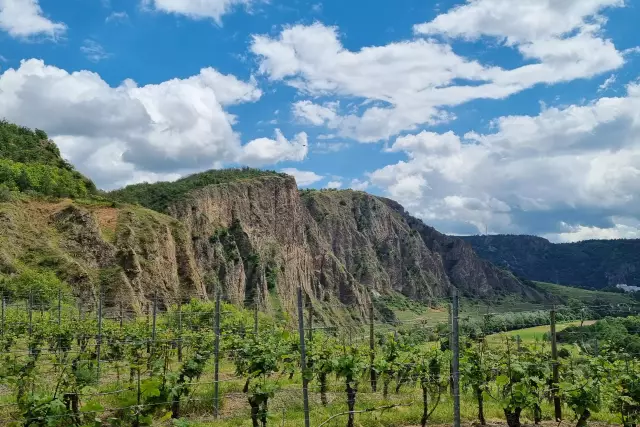A profile of the 13 German wine-growing regions
The German Wine Institute (DWI) has analysed what particularly distinguishes the 13 German wine-growing regions based on the Destatis vineyard survey for 2023.

Ahr
With 531 hectares, the Ahr is one of the smaller growing regions in Germany. In 2023, the vineyard area grew by two hectares compared to the previous year. However, it has still not reached the level of 564 hectares that the region had before the flood disaster in 2021. With 79 per cent red grapes in cultivation, the Ahr has the highest percentage of red wine of all wine-growing regions. Around two thirds of the Ahr vineyards are planted with Spätburgunder (342 ha).
Baden
Baden is a land of Burgundy. In Germany's third largest wine-growing region (15,679 ha), grape varieties from the Burgundy family (9,763 ha) account for a total of 62 per cent of the vineyards. Baden is number one in Germany for Pinot Noir (5,029 ha) and Pinot Blanc (1,660 ha). The new Souvignier Gris variety, which was bred in Freiburg, is now grown on 123 hectares in Baden, making it the most widely cultivated variety in the country. Chasselas (1,021 hectares) is a regional speciality in Markgräflerland.
Franken
The Franconians are particularly proud of their most important grape variety, the Silvaner. With 1,563 hectares, it covers a quarter of Franconia's vineyards. The Müller-Thurgau (1,375 ha) is also very important along the Main. Together, these two varieties account for almost half of Franconian viticulture. 83 per cent of the 6,173-hectare growing area is planted with white varieties.
Hessische Bergstraße
With 461 hectares of vineyards, the Hessische Bergstraße ceded its position as the smallest German wine-growing region to the Middle Rhine last year. It had taken over this position from Saxony in 2007, where viticulture was expanded. White wine varieties, above all Riesling (164 ha) and Pinot Gris (59 ha), characterise the wine region at the foot of the Odenwald.
Mittelrhein
After losing six hectares of vineyards last year, the Middle Rhine is now the smallest wine-growing region in Germany, with 460 hectares. Riesling dominates in the Middle Rhine Valley. It is grown in almost two thirds of the vineyards that stretch from Bingen to the gates of Bonn and as far as Koblenz in the UNESCO World Heritage Site.
Mosel
Along the Moselle and the side valleys of the Saar and Ruwer, 91 per cent of the 8,536 hectares are planted with white grape varieties. This proportion of white wine is the highest in Germany. Riesling in particular thrives there on 5,330 hectares. A speciality of the Moselle is the Elbling variety (425 hectares), which was replaced last year by Pinot Noir (435 hectares) as the third most important variety. With around 3,400 hectares of vineyards on steep slopes with a gradient of 30 per cent or more, the Moselle region is the largest steep-slope wine-growing area in the world.
Nahe
With 4,250 hectares, the Nahe is one of the medium-sized German wine-growing regions. The soil diversity typical of the region is offset by a relatively large variety of grape varieties, three quarters of which are white. In addition to the dominant Riesling (1,244 ha), Burgundy varieties (1,158) are also popular on the Nahe.
Pfalz
Riesling vines grow on 5,954 hectares in the Palatinate. This makes the Palatinate the largest Riesling-growing region in the world. With 7,535 hectares of red wine, it is also Germany's largest red wine-growing region. In addition to the classic red varieties, around half of Germany's Merlot (429 hectares), Cabernet Sauvignon (256 hectares), Syrah (71 hectares) and Cabernet Franc (64 hectares) are also cultivated in the Palatinate. In the white wine sector, the Palatinate also leads with a 40 per cent share of Sauvignon Blanc cultivation nationwide (798 ha). The vineyards cover a total of 23,793 hectares along the approximately 80-kilometre-long wine route, which corresponds to almost a quarter of the local vineyards.
Rheingau
The Rheingau has the clearest grape variety profile of all German wine-growing regions. It is particularly known for Riesling (2,441 hectares), which grows on 76 per cent of the region's 3,207 hectares of vineyards. This means that the Rheingau has the highest percentage of Riesling in Germany. Of the red grape varieties grown on 473 hectares in the Rheingau, 85 per cent are Pinot Noir (403 hectares).
Rheinhessen
As the largest German wine-growing region, Rheinhessen has a good quarter (27,499 hectares) of the total German vineyard area. Following an increase of 110 hectares of Pinot Gris to 2,424 hectares last year, Rheinhessen has overtaken Baden (2,398 hectares) as the most important region for this variety and is also in first place nationwide for Chardonnay (1,087 hectares). Rheinhessen is Germany's number two for Riesling (5,383 ha). In addition, 43 per cent of Silvaner (1,875 ha) and a good third of Germany's Müller-Thurgau (3,834 ha) are grown in Rheinhessen, albeit with a declining trend. The area planted with the new Souvignier Gris variety almost tripled from 35 ha to 96 ha in 2023 compared to the previous year.
Saale-Unstrut
The Saale-Unstrut wine-growing region has more than doubled its vineyard area since reunification from 390 hectares to 853 hectares in 2023. This makes it the largest of the five small German wine-growing regions with less than 1,000 hectares of vineyards. Geographically speaking, Saale-Unstrut lies at the northern end of German quality wine growing. The region is particularly proud of its Pinot Blanc (117 hectares), which, together with Müller-Thurgau (122 hectares), is one of the most important grape varieties in the region at the 51st parallel.
Sachsen
Sachsen has also expanded its vineyard area relatively significantly since 1990, from 300 hectares to 522 hectares last year. In Germany's easternmost wine-growing region, the effects of climate change are very noticeable. Here, Riesling (74 hectares), which ripens relatively late, is now the most important grape variety, as is often the case in the south-western wine regions. Of the red wine varieties, which make up around a fifth of Saxony's viticulture, Pinot Noir accounts for almost half of the area (46 ha).
Württemberg
Germany's second largest red wine region (7,327 ha) Württemberg stands for the Trollinger (1,855 ha) and Lemberger (1,757 ha) varieties like no other region. Pinot Noir (1,302 ha) and Schwarzriesling (1,175 ha) also play a major role in red wine cultivation (7,327 ha), which accounts for almost two thirds of the total 11,392 hectares of vineyards. Württemberger Weingärtner presses over half of the white wine from Riesling grapes (2,120 ha).
Contact persons
-
Ernst Büscher
Press officer


